Towards Mid-Infrared Gas-Discharge Fiber Lasers
Abstract
1. Introduction
2. Experimental Setup
3. Results and Discussion
3.1. Start of GDFL Generation
- The negative slope of the laser pulses could indicate the excessive pressure inside the hollow core, as follows from our previous work [33]. In that work, the He–Xe GDFL operating in steady-state conditions was studied, and the shape of the laser pulses was investigated as a function of gas pressure. Pulse shapes similar to those in Figure 3b were observed only when the gas pressure was above ~150 torr, and the slope was increasing with pressure up to self-termination of laser oscillations at pressures as high as 300 torr [33].
- 2.
- Since the too-small diameter of the capillaries prevents them from maintaining the discharge, the discharge ignition takes place in the hollow core only. As a result, the gas pressure difference occurs between the core and capillaries. This pressure difference could lead to significant changes in the HCF optical losses [35,36], thus influencing the level of output laser power during the transient process that follows the discharge ignition. The relaxation times in this case will be, apparently, of the same order as discussed in the previous paragraph.
- 3.
- As it has been recently observed [37], the self-cleaning effect, which consists of removing the molecular gas impurities out of the gas mixture, takes place in the hollow core for our experimental conditions. At the very beginning of the gas discharge, spontaneous emission of such molecular impurities as nitrogen, OH-groups, oxygen, and even hydrogen can be observed from the side surface of the HCF. The emission of these impurities reduces slowly on a time scale of the order of 100 s. In principle, the removal of the impurities could be accompanied by improving the conditions for laser generation, and consequently, the output laser power could show growth during some hundreds of seconds.
3.2. Possibility of Extending the GDFL Operation to Other Wavelengths
4. Conclusions
Author Contributions
Funding
Data Availability Statement
Conflicts of Interest
References
- Jackson, S.D.; Jain, R.K. Fiber-based sources of coherent MIR radiation: Key advances and future prospects (invited). Opt. Express 2020, 28, 30964–31019. [Google Scholar] [CrossRef]
- Jobin, F.; Paradis, P.; Aydin, Y.O.; Boilard, T.; Fortin, V.; Gauthier, J.-C.; Lemieux-Tanguay, M.; Magnan-Saucier, S.; Michaud, L.-C.; Mondor, S.; et al. Recent developments in lanthanide-doped mid-infrared fluoride fiber lasers [Invited]. Opt. Express 2022, 30, 8615–8640. [Google Scholar] [CrossRef]
- Koltashev, V.V.; Denker, B.I.; Galagan, B.I.; Snopatin, G.E.; Sukhanov, M.V.; Sverchkov, S.E.; Velmuzhov, A.P.; Plotnichenko, V.G. 150 mW Tb3+ doped chalcogenide glass fiber laser emitting at λ > 5 μm. Opt. Laser Technol. 2023, 161, 109233. [Google Scholar] [CrossRef]
- Galagan, B.I.; Velmuzhov, A.P.; Denker, B.I.; Koltashev, V.V.; Plotnichenko, V.G.; Sverchkov, S.E.; Snopatin, G.E.; Sukhanov, M.V.; Frolov, M.P. Five-micron Ce3+ ion fiber laser. Appl. Photonics 2023, 10, 42–50. [Google Scholar] [CrossRef]
- Dai, S.; Wang, Y.; Peng, X.; Zhang, P.; Wang, X.; Xu, Y. A Review of Mid-Infrared Supercontinuum Generation in Chalcogenide Glass Fibers. Appl. Sci. 2018, 8, 707. [Google Scholar] [CrossRef]
- Woyessa, G.; Kwarkye, K.; Dasa, M.K.; Petersen, C.R.; Sidharthan, R.; Chen, S.; Yoo, S.; Bang, O. Power stable 1.5–10.5 µm cascaded mid-infrared supercontinuum laser without thulium amplifier. Opt. Lett. 2021, 46, 1129–1132. [Google Scholar] [CrossRef] [PubMed]
- Markos, C.; Travers, J.C.; Abdolvand, A.; Eggleton, B.J.; Bang, O. Hybrid photonic-crystal fiber. Rev. Mod. Phys. 2017, 89, 045003. [Google Scholar] [CrossRef]
- Debord, B.; Amrani, F.; Vincetti, L.; Gérôme, F.; Benabid, F. Hollow-core fiber technology: The rising of “gas photonics”. Fibers 2019, 7, 16. [Google Scholar] [CrossRef]
- Pryamikov, A.D.; Gladyshev, A.V.; Kosolapov, A.F.; Bufetov, I.A. Hollow-core fibers: State-of-the-art and prospects. Phys. Usp. 2024, 67, 138–168. [Google Scholar] [CrossRef]
- Pryamikov, A.D.; Biriukov, A.S.; Kosolapov, A.F.; Plotnichenko, V.G.; Semjonov, S.L.; Dianov, E.M. Demonstration of a waveguide regime for a silica hollow--core microstructured optical fiber with a negative curvature of the core boundary in the spectral region > 3.5 μm. Opt. Express 2011, 19, 1441–1448. [Google Scholar] [CrossRef] [PubMed]
- Wang, Y.Y.; Wheeler, N.V.; Couny, F.; Roberts, P.J.; Benabid, F. Low loss broadband transmission in hypocycloid—Core Kagome hollow—Core photonic crystal fiber. Opt. Lett. 2011, 36, 669–671. [Google Scholar] [CrossRef]
- Kolyadin, A.N.; Kosolapov, A.F.; Pryamikov, A.D.; Biriukov, A.S.; Plotnichenko, V.G.; Dianov, E.M. Light transmission in negative curvature hollow core fiber in extremely high material loss region. Opt. Express 2013, 21, 9514–9519. [Google Scholar] [CrossRef]
- Yu, F.; Wadsworth, W.J.; Knight, J.C. Low loss silica hollow core fibers for 3–4 μm spectral region. Opt. Express 2012, 20, 11153–11158. [Google Scholar] [CrossRef]
- Gladyshev, A.V.; Dubrovsky, D.S.; Zhuravleva, E.E.; Kosolapov, A.F.; Yatsenko, Y.P.; Bufetov, I.A. Raman Generation of ps Pulses at λ = 3.9 μm in a Hollow-Core Revolver Fiber. Optoelectron. Instrument. Proc. 2023, 59, 10–17. [Google Scholar] [CrossRef]
- Astapovich, M.S.; Gladyshev, A.V.; Khudyakov, M.M.; Kosolapov, A.F.; Likhachev, M.E.; Bufetov, I.A. Watt-Level Nanosecond 4.42-um Raman Laser Based on Silica Fiber. IEEE Photonics Technol. Lett. 2019, 31, 78–81. [Google Scholar] [CrossRef]
- Zhang, X.; Peng, Z.; Dong, Z.; Yao, P.; Hou, Y.; Wang, P. High-power mid-infrared 2.8-μm ultrafast Raman laser based on methane-filled anti-resonant fiber. IEEE Photon. Technol. Lett. 2022, 34, 1007–1010. [Google Scholar] [CrossRef]
- Cui, Y.; Tian, X.; Rao, B.; Li, H.; Huang, W.; Pei, W.; Wang, M.; Chen, Z.; Wang, Z. A 110 W fiber gas Raman laser at 1153 nm. High Power Laser Sci. Eng. 2023, 11, e10. [Google Scholar] [CrossRef]
- Huang, W.; Wang, Z.; Zhou, Z.; Pei, W.; Cui, Y.; Li, X.; Li, Z.; Chen, J. Tunable fiber gas Raman laser of 6 W at 2.9 μm by deuterium-filled hollow-core fiber. IEEE J. Sel. Top. Quantum Electron. 2023. Early Access. [Google Scholar] [CrossRef]
- Gladyshev, A.; Yatsenko, Y.; Kolyadin, A.; Kompanets, V.; Bufetov, I. Mid-infrared 10-µJ-level sub-picosecond pulse generation via stimulated Raman scattering in a gas-filled revolver fiber. Opt. Mater. Express 2020, 10, 3081–3089. [Google Scholar] [CrossRef]
- Gladyshev, A.; Yatsenko, Y.; Kolyadin, A.; Bufetov, I. Visible to mid-infrared supercontinuum initiated by stimulated Raman scattering of 1.03 μm ultrashort pulses in a gas-filled silica fiber. Photonics 2022, 9, 997. [Google Scholar] [CrossRef]
- Xu, M.; Yu, F.; Hassan, M.R.A.; Knight, J.C. Continuous-Wave Mid-Infrared Gas Fiber Lasers. IEEE J. Sel. Top. Quantum Electron. 2018, 24, 0902308. [Google Scholar] [CrossRef]
- Huang, W.; Wang, Z.; Zhou, Z.; Cui, Y.; Li, H.; Pei, W.; Wang, M.; Chen, J. Fiber laser source of 8 W at 3.1 µm based on acetylene-filled hollow-core silica fibers. Opt. Lett. 2022, 47, 2354–2357. [Google Scholar] [CrossRef]
- Zhou, Z.; Huang, W.; Cui, Y.; Li, H.; Pei, W.; Li, X.; Li, Z.; Wang, M.; Wang, Z. 3.1 W mid-infrared fiber laser at 4.16 μm based on HBr-filled hollow-core silica fibers. Opt. Lett. 2022, 47, 5785–5788. [Google Scholar] [CrossRef]
- Cui, Y.; Wang, Z.; Zhou, Z.; Huang, W.; Li, H.; Wang, M.; Gao, S.; Wang, Y. Towards High-Power Densely Step-Tunable Mid-Infrared Fiber Source from 4.27 to 4.43 µm in CO2-Filled Anti-Resonant Hollow-Core Silica Fibers. J. Light. Technol. 2022, 40, 2503–2510. [Google Scholar] [CrossRef]
- Li, X.; Yang, L.; Xu, Y.; Zhou, Z.; Huang, W.; Wang, M.; Wang, Z. CO-filled hollow-core fiber lasers operating at 4.64–4.82 μm. In Proceedings of the Fifth International Symposium on High Power Laser Science and Engineering (HPLSE 2023), Suzhou, China, 22 December 2023; Volume 12974G. [Google Scholar] [CrossRef]
- Shi, X.; Wang, X.B.; Jin, W.; Demokan, M.S. Investigation of glow discharge of gas in hollow-core fibers. Appl. Phys. B 2008, 91, 377–380. [Google Scholar] [CrossRef]
- Debord, B.; Jamier, R.; Gérôme, F.; Leroy, O.; Boisse-Laporte, C.; Leprince, P.; Alves, L.L.; Benabid, F. Generation and confinement of microwave gas-plasma in photonic dielectric microstructure. Opt. Express 2013, 21, 25509–25516. [Google Scholar] [CrossRef]
- Bateman, S.A.; Belardi, W.; Yu, F.; Webb, C.E.; Wadsworth, W.J. Gain from Helium-Xenon Discharges in Hollow Optical Fibres at 3 to 3.5 µm. In Proceedings of the CLEO: Science and Innovations 2014, San Jose, CA, USA, 8–13 June 2014. paper STh5C.10. [Google Scholar]
- Love, A.L.; Bateman, S.A.; Belardi, W.; Webb, C.E.; Wadsworth, W.J. Double Pass Gain in Helium-Xenon Discharges in Hollow Optical Fibres at 3.5 μm. In Proceedings of the CLEO: Science and Innovations 2015, San Jose, CA, USA, 10–15 May 2015. paper SF2F.4. [Google Scholar]
- Heidt, A.M.; Bradley, T.; Wheeler, N.; Petrovich, M.; Ryser, M.; Feurer, T. Non-invasive Excitation of Meter-scale Electric Discharges in Gas-filled Hollow-core Photonic Crystal Fibers. In Proceedings of the Advanced Photonics Congress, Zurich, Switzerland, 2–5 July 2018; p. SoTh2H.2. [Google Scholar] [CrossRef]
- Gladyshev, A.; Nefedov, S.; Kolyadin, A.; Kosolapov, A.; Velmiskin, V.; Mineev, A.; Bufetov, I. Microwave Discharge in Hollow Optical Fibers as a Pump for Gas Fiber Lasers. Photonics 2022, 9, 752. [Google Scholar] [CrossRef]
- Gladyshev, A.V.; Komissarov, D.G.; Nefedov, S.M.; Kosolapov, A.F.; Velmiskin, V.V.; Mineev, A.P.; Bufetov, I.A. Gas-Discharge Fiber Laser with Microwave Pumping. Bull. Lebedev Phys. Inst. 2023, 50, 403–408. [Google Scholar] [CrossRef]
- Gladyshev, A.W.; Komissarov, D.G.; Nefedov, S.M.; Kosolapov, A.F.; Velmiskin, V.V.; Mineev, A.P.; Bufetov, I.A. Gas-Discharge He-Xe Fiber Laser. IEEE J. Sel. Top. Quantum Electron. 2024, 30, 0900107. [Google Scholar] [CrossRef]
- Solovyov, I.A. Helium-Xenon Laser with Microwave Excitation and Tunable Parameters. Ph.D. Thesis, Institute of Laser Physics, Siberian Branch of the Russian Academy of Sciences, Novosibirsk, Russia, 1992. (In Russian). [Google Scholar]
- Kelly, T.W.; Horak, P.; Davidson, I.A.; Partridge, M.; Jasion, G.T.; Rikimi, S.; Taranta, A.; Richardson, D.J.; Poletti, F.; Wheeler, N.V. Gas-induced differential refractive index enhanced guidance in hollow-core optical fibers. Optica 2021, 8, 916–920. [Google Scholar] [CrossRef]
- Rikimi, S.; Kelly, T.W.; Horak, P.; Davidson, I.A.; Chen, Y.; Bawn, S.; Bradley, T.D.; Taranta, A.A.; Poletti, F.; Richardson, D.J.; et al. Transient differential pressure-induced loss variation in as-drawn hollow core optical fibres. Proc. SPIE 2022, 12140, 1214002. [Google Scholar] [CrossRef]
- Gladyshev, A.V.; Komissarov, D.G.; Nefedov, S.M.; Kosolapov, A.F.; Velmiskin, V.V.; Bufetova, G.A.; Mineev, A.P.; Bufetov, I.A. Properties of Microwave Discharge in a Hollow-Core Fiber of a Gas-Discharge Fiber Laser. Quantum Electron. 2023, 53, 755–760. Available online: https://quantum-electronics.ru/2023-tom-53-nomer-10/ (accessed on 28 February 2024). (translation into English: Bull. Lebedev Phys. Inst. 2023, (in press))(In Russian).
- Bufetov, I.A.; Kolyadin, A.N.; Yatsenko, Y.P.; Kosolapov, A.F. Spectral diagnostics of an optical discharge propagating along a hollow-core optical fibre. Quantum Electron. 2021, 51, 232–239. [Google Scholar] [CrossRef]
- Endo, M.; Walter, R.F. (Eds.) Gas Lasers; CRC Press: Boca Raton, FL, USA; Taylor & Francis Group: New York, NY, USA; London, UK, 2007. [Google Scholar]
- Lawton, S.A.; Richards, J.B.; Newman, L.A.; Specht, L.; DeTemple, T.A. The high-pressure neutral infrared xenon laser. J. Appl. Phys. 1979, 50, 3888–3898. [Google Scholar] [CrossRef]
- Basov, N.; Chugunov, A.; Danilychev, V.; Kholin, I.; Ustinovsky, M. Powerful electroionization laser on Xe infrared atomic transitions. IEEE J. Quantum Electron. 1983, 19, 126–128. [Google Scholar] [CrossRef]
- Basov, N.; Baranov, V.; Chugunov, A.; Danilychev, V.; Dudin, A.; Kholin, I.; Ustinovskii, N.; Zayarnyi, D. 60 J quasistationary electroionization laser on Xe atomic metastables. IEEE J. Quantum Electron. 1985, 21, 1756–1760. [Google Scholar] [CrossRef]
- Ohwa, M.; Moratz, T.J.; Kushner, M.J. Excitation mechanisms of the electron-beam-pumped atomic xenon (5d→6p) laser in Ar/Xe mixtures. J. Appl. Phys. 1989, 66, 5131–5145. [Google Scholar] [CrossRef]
- Kleen, W.; Müller, R. Laser; Springer: Berlin/Heidelberg, Germany, 1969; p. 251. (In German) [Google Scholar]
- White, A.D.; Rigden, J.D. The effect of super-radiance at 3.39 m on the visible transitions in the He-Ne maser. Appl. Phys. Lett. 1963, 2, 211–212. [Google Scholar] [CrossRef]
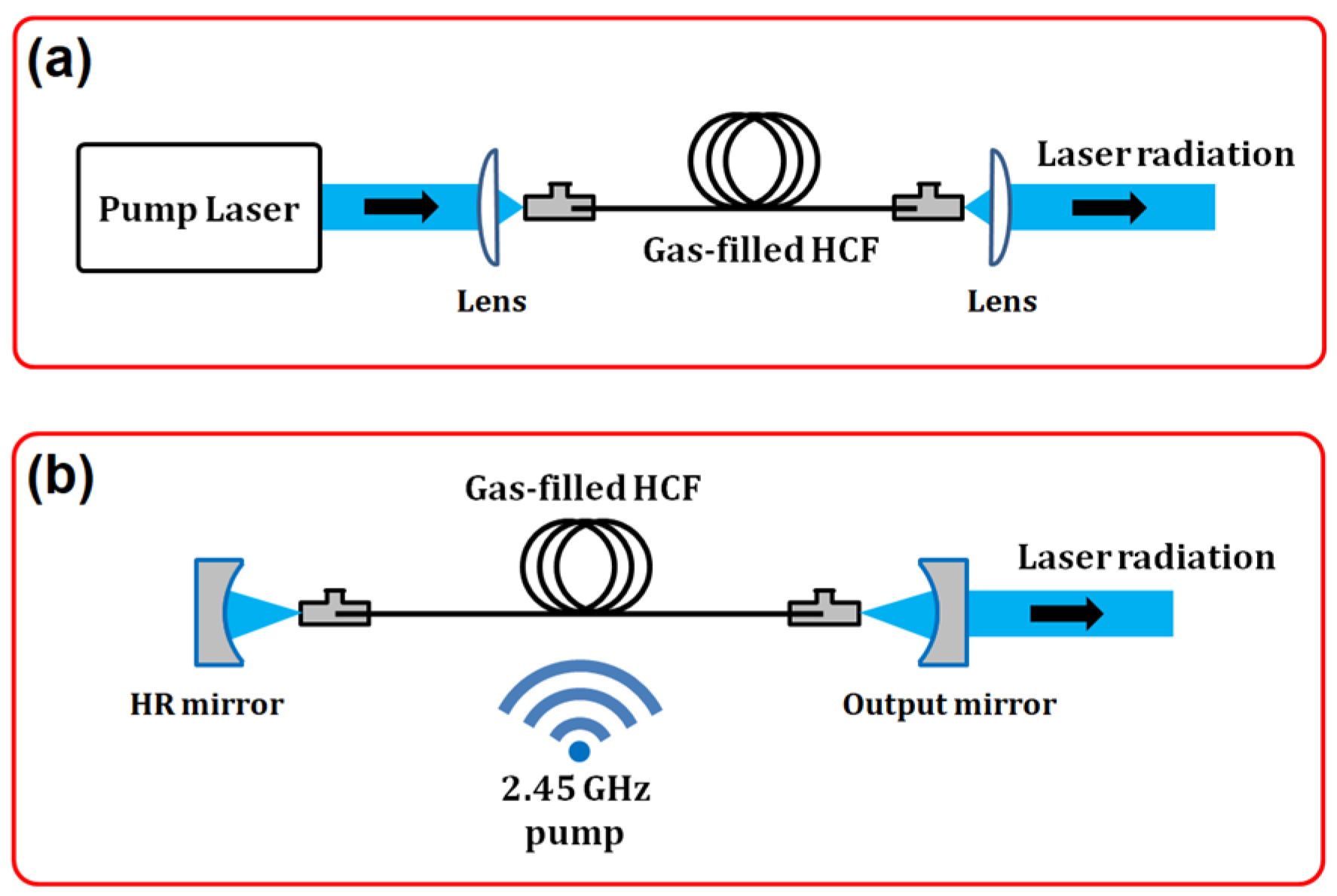
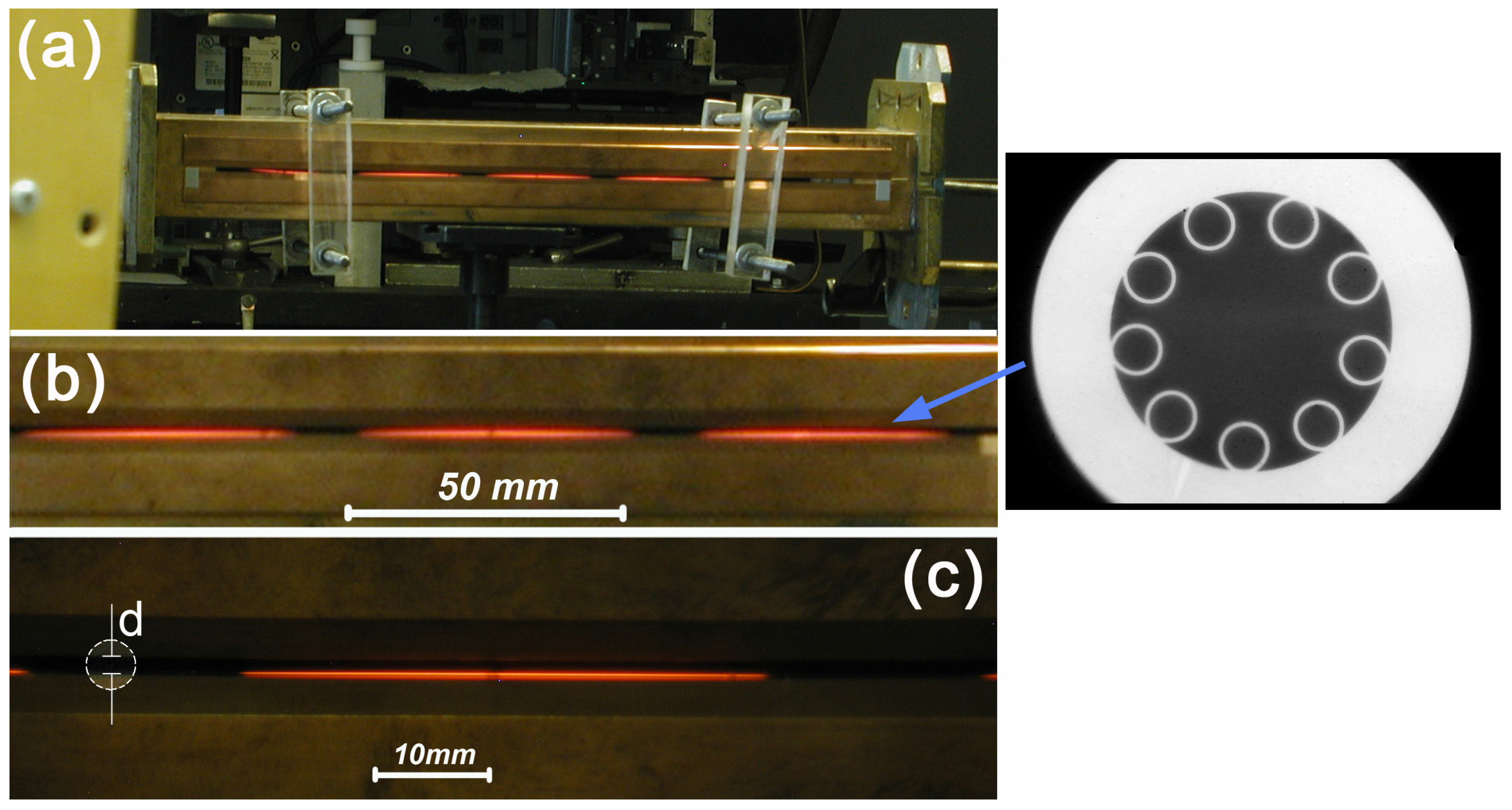

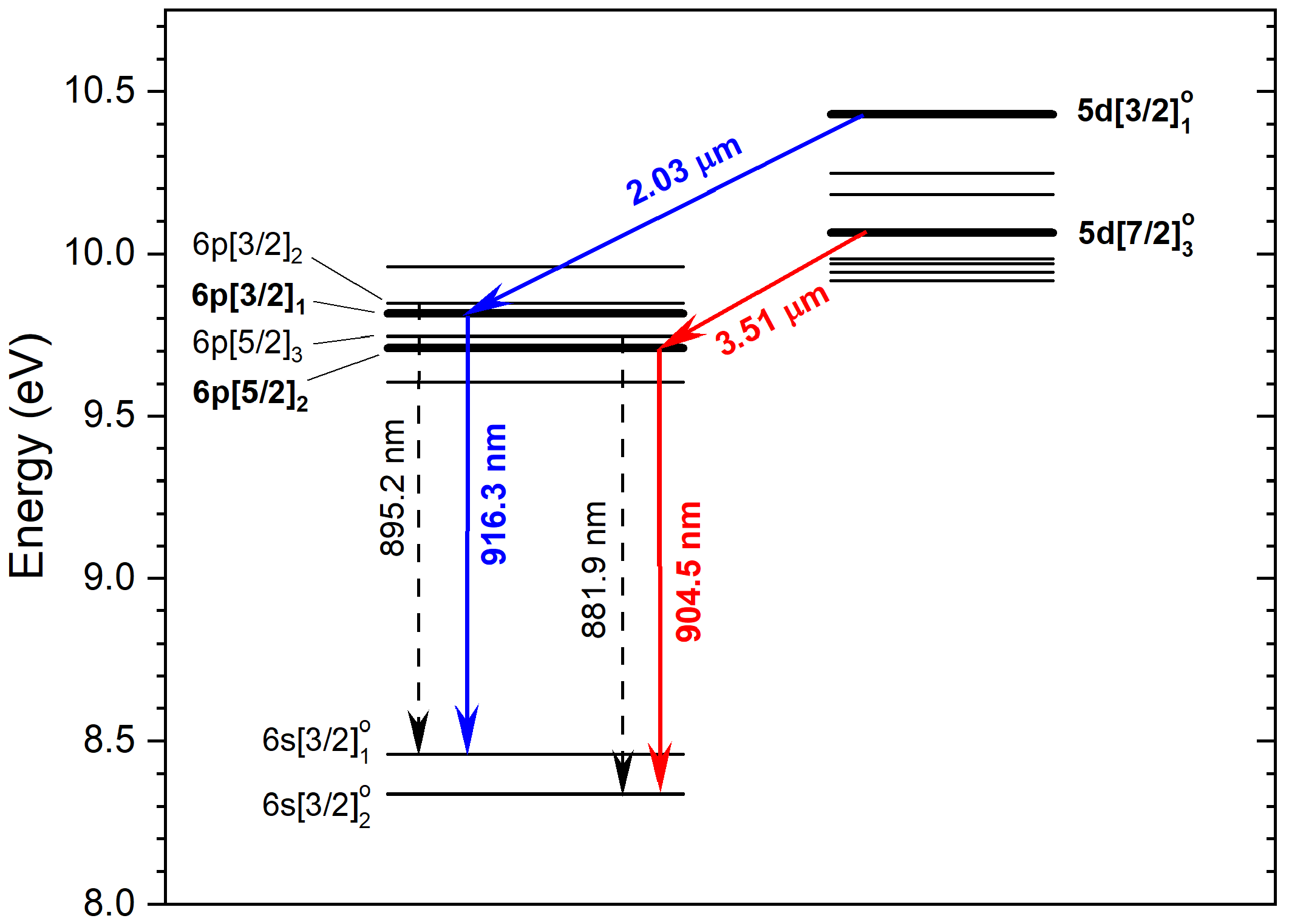
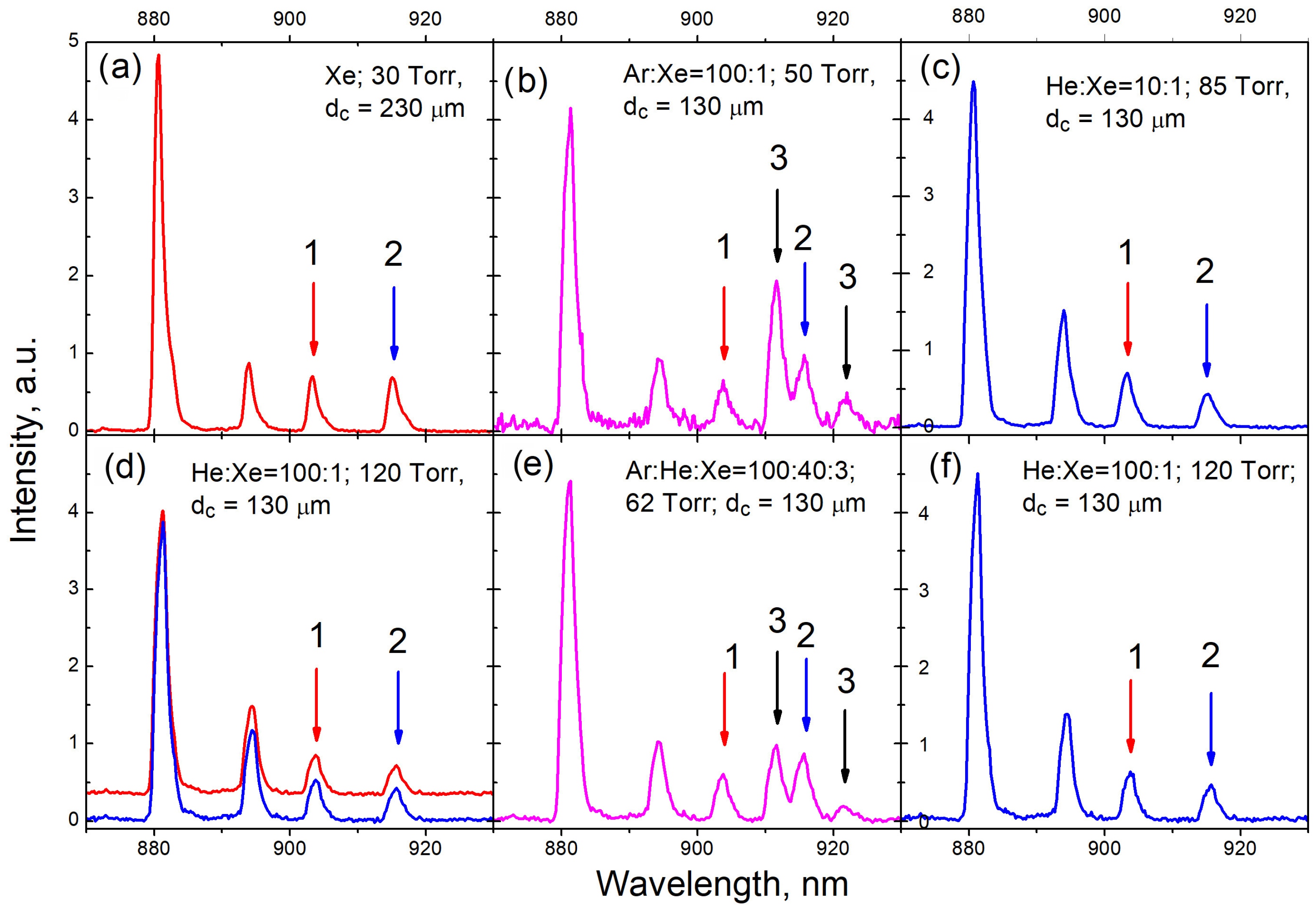
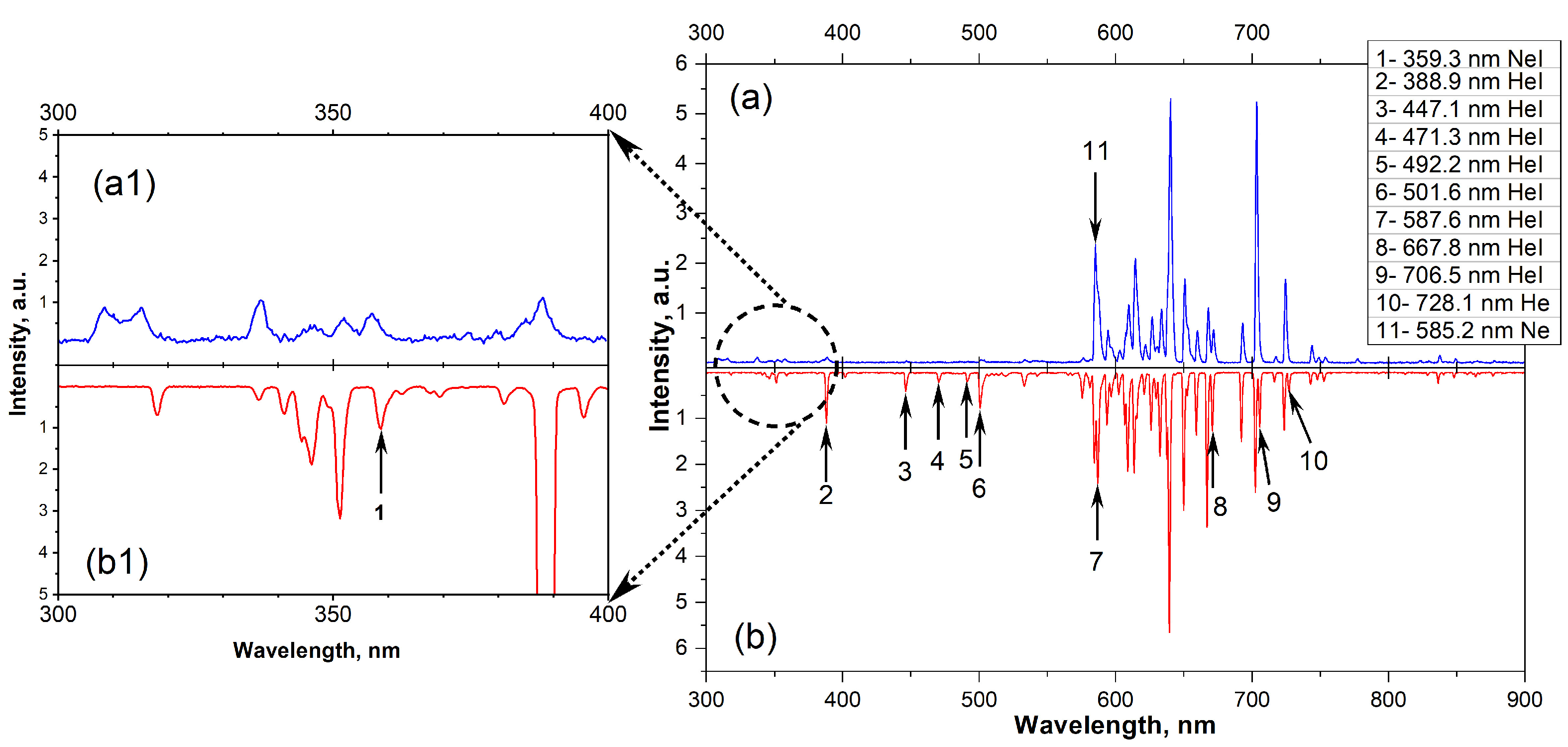
Disclaimer/Publisher’s Note: The statements, opinions and data contained in all publications are solely those of the individual author(s) and contributor(s) and not of MDPI and/or the editor(s). MDPI and/or the editor(s) disclaim responsibility for any injury to people or property resulting from any ideas, methods, instructions or products referred to in the content. |
© 2024 by the authors. Licensee MDPI, Basel, Switzerland. This article is an open access article distributed under the terms and conditions of the Creative Commons Attribution (CC BY) license (https://creativecommons.org/licenses/by/4.0/).
Share and Cite
Gladyshev, A.; Komissarov, D.; Nefedov, S.; Kosolapov, A.; Velmiskin, V.; Mineev, A.; Bufetov, I. Towards Mid-Infrared Gas-Discharge Fiber Lasers. Photonics 2024, 11, 242. https://doi.org/10.3390/photonics11030242
Gladyshev A, Komissarov D, Nefedov S, Kosolapov A, Velmiskin V, Mineev A, Bufetov I. Towards Mid-Infrared Gas-Discharge Fiber Lasers. Photonics. 2024; 11(3):242. https://doi.org/10.3390/photonics11030242
Chicago/Turabian StyleGladyshev, Alexey, Dmitry Komissarov, Sergey Nefedov, Alexey Kosolapov, Vladimir Velmiskin, Alexander Mineev, and Igor Bufetov. 2024. "Towards Mid-Infrared Gas-Discharge Fiber Lasers" Photonics 11, no. 3: 242. https://doi.org/10.3390/photonics11030242
APA StyleGladyshev, A., Komissarov, D., Nefedov, S., Kosolapov, A., Velmiskin, V., Mineev, A., & Bufetov, I. (2024). Towards Mid-Infrared Gas-Discharge Fiber Lasers. Photonics, 11(3), 242. https://doi.org/10.3390/photonics11030242




